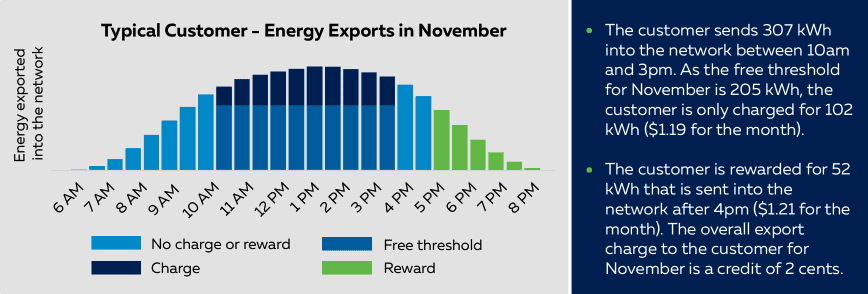There’s been a fair bit of noise about the so-called “sun tax” that solar households in the Ausgrid network (Sydney/Hunter/Central Coast) will soon be subject to.
It seems people are more annoyed about the principle than what will happen in practice. So, I wanted to share my view on why solar is still a great investment and why the new 2-way network solar tariff won’t matter.
First, let’s unpack the 2-way solar tariff and when this starts.
Much ado about nothing this year
From July 1, 2024, the 2-way solar network tariff is opt-in. Customers will only sign up this year if they were automatically moved across from the previous EA959 2-way tariff trial in Ausgrid. The EA959 paid a crazy 27-cent FiT for exports from the network after 4 p.m., which offset the 1.2 cent/kWh middle of the day export charge.
It really only kicks off next year.
From July 1, 2025, Ausgrid will move all residential and small business customers with solar (or presumably at least those with an interval meter) to the 2-way solar tariff.
Downside + upside = little real change.
The 2-way tariff includes a free threshold of ~6.8kWh of solar energy that can be exported each day at no cost between 10 am and 3 pm. The free threshold is calculated by month, varying between 192kWh/month and 212/kWh, depending on the length of the month. Any export after that attracts a 1.2 cent/kWh network charge.
From 4 pm to 9 pm, the network will pay a 2.3 cent/kWh reward for any solar exports.
Ausgrid Solar Tax unpacked – here’s how the 2 way tariffs works

Next, we’ll examine why the network is doing this and why the 2-way tariff is more likely to annoy solar owners rather than achieve any shift in behaviour.
Why are Ausgrid doing this?
The networks explains that as more residential and small business customers invest in their energy solutions, they use Ausgrid’s distribution networks to receive electricity and export solar energy back to the grid. This changing use of their network means they also need to change to support the exported energy while providing a safe, reliable supply to all customers. There is a cost to making this change.
Ausgrid says that “they want to encourage customers to send their exports into the grid later in the day. So this tariff encourages customers to consume their self-generated electricity themselves or time their grid exports to later.”
Designed to fail
Some network tariff designs are unlikely to achieve their objective. That happens when the costs and rewards are so small that they will motivate only a very few people.
If, according to Ausgrid’s modelling, the 2-way tariff results in an annual reduction in the value of solar exports of just $6.60 each year for customers with a 5kW system, it’s not worth the ink on the retailer’s bill to include two rates.
Ausgrid’s network prices (and two-way tariffs) will be passed to retailers. But ultimately, it’s the retailer who will determine what’s on the customer’s bill. The minor difference in cost and reward means that many retailers may not be bothered to provide time-varying feed-in tariffs. When retailers don’t pass through the price signal, consumers don’t change their behaviour, and the tariff fails.
Big solar owners may notice small changes
Retailers generally keep things simple for customers. Based on the very few retailers who have ever offered time-varying FiTs, it seems unlikely they’ll be a stampede, unless the cost and reward increase.
For households with bigger systems, say a 13.2kW set-up, the impact of network cost will be more material. However, since many of these customers are on two-tiered FiTs (offset by higher grid rates), they may likely see a minor reduction in the headline FiT and a little more trimmed from the second tier.
Let’s be honest. If they generate 40kWh per day and export 60% or more, there’s a limit to how much more they could self-consume. On top of that, the 2.3c/kWk reward isn’t sufficient incentive to get a battery and export later in the day. VPP rewards or exporting into high market prices via a retailer like Amber is a far more valuable incentive.
The real game for solar in 2024
The 2-way solar tariff won’t change the real reason for getting solar. That’s because the most significant saving has always come from reducing the expensive energy households need to buy from the grid. With electricity rates staying high, solar is the best way to slash electricity cost. The feed-in tariff is just cream on top for any energy generated that households can’t use. So the 2-way solar tariff won’t dramatically change the ROI on adding panels to your roof. This is still compelling, even with the declining value of the STC rebate. Solar is one of those rare household investments that pays for itself and makes money – tax-free.
It may prompt prospective owners to think a little harder about right-sizing their system or pairing storage with their PV panels. But most will happily go about their way, and the solar industry will continue to sell average systems approaching 10kW.
So if someone remarks that solar is now not worth it, I’d say, “Yeah…No. Solar is still a smart investment.” It was always about generating cheap power for your home – and a sense of self-sufficiency that reduces the impact of surging electricity prices. Solar feed-in tariffs are a bonus.

